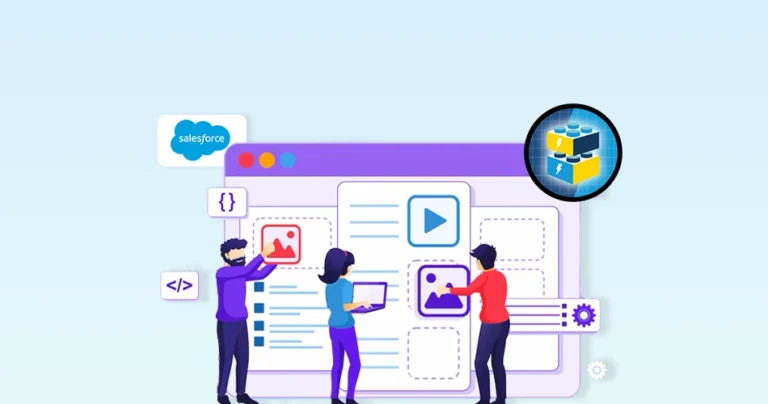Salesforce developers constantly seek faster, more efficient ways to build scalable applications—that’s where Lightning Web Components come in. As a modern JavaScript framework built on web standards, LWC simplifies development while boosting performance. That makes it a game-changer for Salesforce ecosystems.
Whether you’re streamlining CRM workflows or creating dynamic user interfaces, LWC is for you. It’s lightweight architecture ensures seamless integration and faster load times.
This blog is aimed at shedding some light on how a dedicated experts builds lightning web components to enhance development with cutting-edge technology. Let’s begin.
What are Lightning Web Components?
Lightning Web Components (LWC) is a modern Salesforce framework for building fast, lightweight, and secure web applications. Built on standard HTML, JavaScript, and CSS, LWC leverages native browser capabilities instead of relying on heavy abstractions.
Unlike its predecessor, Aura Components, LWC follows modern web standards (Web Components) for better performance and easier maintenance.
Developers use LWC to create reusable, modular UI elements within Salesforce. It enhances CRM workflows, dashboards, and custom apps. Key advantages include:
- Faster rendering (due to lightweight architecture)
- Better interoperability with other frameworks
- Improved security (aligned with web component standards)
- Simplified debugging with native browser tools
hire Ecommerce experts to leverage LWC as the future of efficient, scalable app development.
Lightning Web Components vs Aura
Salesforce offers two frameworks for building dynamic user interfaces: Lightning Web Components and Aura Components. While both integrate with the Lightning Platform, they differ significantly in architecture, performance, and development approach.
Aura pioneered component-based development in Salesforce. But it relies on a heavier abstraction layer, making it slower and harder to debug. LWC is built on native browser APIs. That delivers better performance, simpler syntax, and closer alignment with JavaScript best practices.
Aura still powers legacy Lightning apps, but LWC is now the recommended choice for new development. That blends seamless Salesforce integration with the efficiency of standard web technologies. For developers, this means faster load times, easier maintenance, and future-proofed applications.
Considerations Before Building Lightning Web Components for Salesforce
Before diving into LWC development, assess these critical factors to ensure efficiency, scalability, and long-term success:
Use Case & Compatibility
Is LWC the right fit? Use LWC for modern, performance-critical UIs, but stick with Aura if you need:
- Legacy Lightning features are not yet supported in LWC.
- Complex event handling (Aura’s event system is more flexible).
Check Salesforce’s supported targets (e.g., lightning__AppPage, lightning__RecordPage).
Data Handling Strategy
Decide between:
- Wire Service (reactive, cache-friendly).
- Imperative Apex (for complex logic).
- Lightning Data Service (LDS) (for CRUD without Apex).
Avoid client-side data overfetching—optimize SOQL queries.
Performance & Reusability
Here’s what you need to do to ensure performance and reusability.
- Modularize components for reuse across apps.
- Lazy load non-critical elements.
- Minimize DOM updates with track and @api reactivity.
Security & Compliance
Here’s what you need to do to ensure security and compliance.
- Sanitize dynamic HTML (use lightning-formatted-* components).
- Follow Salesforce’s CSP (Content Security Policy).
Avoid client-side secrets—use Apex for sensitive logic.
Testing & Debugging
Here’s what you need to do for testing and debugging the Salesforce LWC implementation.
- Use Jest for unit testing.
- Leverage browser dev tools (LWC runs on native Web Components).
Also, make sure to plan for cross-browser testing (especially for older orgs).
Adoption & Migration
Here’s what you need for effortless adoption.
- Can you gradually migrate from Aura? (Use Aura wrappers for LWC if needed).
- Train teams on modern JavaScript (ES6+, modules, decorators).
Try to start small–build a proof of concept before scaling it all the way.
How to Create Lightning Web Components for Salesforce?
Lightning Web Components streamline Salesforce development with modern JavaScript and web standards. Here’s a quick guide to building your first LWC:
Set Up Your Environment
Use VS Code with the Salesforce Extension Pack. Enable Dev Hub in your Salesforce org (for Scratch Org development).
Create a New LWC
In VS Code, open the command palette (Ctrl+Shift+P or Cmd+Shift+P) and run:
SFDX: Create Lightning Web Component
Name your component (e.g., helloWorld).
Build the Component
After creating the LWC, it’s time to build the component.
HTML (helloWorld.html)
<template>
<h1>Hello, {name}!</h1>
</template>
JavaScript (helloWorld.js)
import { LightningElement } from 'lwc';
export default class HelloWorld extends LightningElement {
name = 'Salesforce';
}
Configuration (helloWorld.js-meta.xml)
<targets>
<target>lightning__AppPage</target>
</targets>
Deploy & Test
Push to a Scratch Org or Sandbox using:
Add the component to a Lightning App Page via Lightning App Builder.
If you want help with building the best LWCs for your eStore, our professional Salesforce development company can help.
Building with Salesforce? Let us simplify LWC for you.
Lightning Web Component Core Modules
Lightning Web Components follow a modular architecture, leveraging modern JavaScript (ES6+) to organize code efficiently. Let’s look at a few of the core modules in LWC.
lwc (Base Module)
This is the core module for Lightning Web Components. It provides foundational classes like LightningElement and decorators (@track, @api). They can help build reactive, customizable UI components.
import { LightningElement, track, wire, api } from 'lwc';
Key Components
- LightningElement: Base class for all LWCs (replaces AuraComponent).
- @api: Exposes public properties/methods to parent components.
- @track: Makes private properties reactive (now optional in most cases).
- @wire: Connects to Apex methods or Salesforce data services.
lightning/ui*Api Modules
This collection of modules (lightning/uiRecordApi, lightning/uiObjectInfoApi) fetches Salesforce record data, metadata, and layout details. It’s done using wire adapters for seamless integration.
import { getRecord, getFieldValue } from 'lightning/uiRecordApi';
import { NavigationMixin } from 'lightning/navigation';
Key Components
- getRecord: Fetches a single Salesforce record (uses cache).
- getFieldValue: Extracts a field value from the record.
- uiRecordApi: Fetches record data without Apex.
- NavigationMixin: Handles URL navigation (e.g., redirects).
lightning/messageService
This module enables cross-component communication via Lightning Message Service (LMS). So components in different DOM hierarchies can publish/subscribe to messages dynamically.
import { publish, subscribe } from 'lightning/messageService';
- subscribe(channel, callback): Listens for messages.
- publish(channel, message): Sends messages.
- MessageContext: Required for @wire-based subscriptions.
It’s this modular design of lightning web components in Salesforce that makes it easier to maintain, test, and scale with ease.
Let’s Summarize
Lightning Web Components represent a significant leap forward in Salesforce development. It combines modern web standards with the power of the Lightning Platform. It leverages native browser capabilities to deliver faster performance and cleaner code. Plus, it offers a more intuitive development experience compared to older frameworks like Aura.
Are you building dynamic interfaces, optimizing CRM workflows, or planning a gradual migration from Aura? Then Salesforce LWC can create scalable, maintainable solutions.
So, want help with implementing lightning web components in Salesforce? Then connect with our experts today!
FAQs on Lightning Web Components Salesforce
Q1. How is LWC different from Aura Components?
LWC uses native browser APIs and modern JavaScript (ES6+). That makes it faster and easier to debug than Aura, which relies on a custom abstraction layer. Aura is still used for legacy features, but LWC is the future of Salesforce UI development.
Q2. Can LWC and Aura components work together?
Yes. LWC can be nested inside Aura components (using lightning:webComponent). But Aura components cannot be embedded in LWC. This allows gradual migration from Aura to LWC.
Q3. How do I fetch data in LWC?
Use @wire for reactive data (e.g., getRecord from lightning/uiRecordApi) or imperative Apex calls for complex logic. Avoid direct REST calls unless necessary.
Q4. Can I migrate from Aura to LWC?
Yes, but incrementally. Wrap LWCs in Aura containers or rebuild components piece by piece. Salesforce provides tools like the LWC Converter for automation.
Q5. How do I communicate between LWCs?
Use pubsub (deprecated), lightning/messageService, or parent-child communication with @api and custom events. Avoid global variables.





